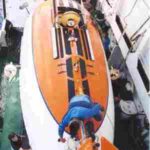How many of you have seen the drama enfold in Disney’s 1954 creation, of the epic story by Jules Verne, “20000 Leagues Under The Sea” ? Where the submarine “the Nautilus” descends to a deep depth only to be pursued by a giant cephalopod and have to try to fight it off or die a tragic death. Captain Nemo definitely had his hands tied during the fighting of the cephalopod in order to save his ship and crew, fortunately we don’t have to go to those extremes when encountering one of these or desiring to obtain one of these for a marine aquarium.
For the most part Octopuses will be the only cephalopod seen in the aquarium trade as Nautilus’, Cuttlefish and Squid are not easily shipped, collected or found. Cephalopods can be found from tropical to cold water at shallow depths down to the deepest and darkest depths throughout the world’s oceans.
Because of the variance of size ranges, this must be considered in purchasing a cephalopod as some can reach a size of a golf ball while others can stretch the ruler to 60. There are roughly 700 species of cephalopods with more being discovered every year.
To incorporate an octopus in a captive environment, you will be required to set up a unique and specialized tank. All cephalopods are opportunistic feeders and carnivores while most can be considered as cannibalistic predators as well. If your goal is to try to house one of the diverse and unique animals, it is best to keep just one of these in a tank with nothing else in the tank unless you plan on it being eaten in due time.
Octopus consist of tentacles ranging in different sizes, colors and number of tentacles ranging from less than 12 to as many as ninety. Some of these tentacles are used for feeding, some for reproduction while others have evolved a siphon of sorts called the hyponone which brings water into its mantle cavity and expelling it out of the siphon as a way of propelling itself. They also have a beak for a mouth which is used for piercing and crushing mollusk and crab shells which comprises most of their diet. Octopus are such smart animals, and are always in the top 10 in terms of the most intelligent animals, up there with rats and dolphins. The reason for this being the assemblage of a brain mass or Ganglia allowing the octopus to perform a variety of tasks such as motor skills, feeding and even opening a jar in efforts to eat the contents that are inside. I have even seen a show on “ANIMAL PLANET” where an octopus was dragging a bottle along the bottom of the ocean and that was its protection as well as its home. Scientist performed an experiment with the octopus by placing another style of bottle next to it in efforts to see what the octopus would do and if it would change homes. The octopus left his existing home to check out the new home, climbed inside for a few seconds then left it for his existing home as it wasn’t to its liking due to size and shape…
Octopuses have the ability to change their color, texture and pattern to coordinate with their environment with chromatophores. This ability to blend in with their surroundings enables them to camouflage themselves to reduce being detected by predators and also to enable them to better seek foods through ambush. Their ability to squeeze into tight spots and flee at quick speeds through the use of their hyponome(siphon) and their evasive nature all help the octopus to live to see another day. Then their is their ability to form and release “ink” known as sepia. This affords the octopus a chance to escape through the deterrent and confusing cloud of ink in various colors. This sepia is a mixture of mucus and pigment called melanin along with an eye irritant and smell reducing agent called tyrosinase.
When deciding on keeping and maintaining an octopus in a captive environment, care must be used to keep the tank well covered and weighed down to reduce the chance of the octopus escaping through the top. Also, the releasing of ink is normally a defense or a stress related action often the final means of being harassed, so care has got to be used to reduce the chances of them inking in a captive environment. If they ink, the can kill everything in the tank plus itself due to the toxins and pollutants in their ink and the depletion of dissolved oxygen. If the octopus does ink, the best bet is to do a quick water change to dilute the ink, plus increase skimming and other means of filtration. Octopuses need to be kept under strict water temperatures on the cool side with very little variance. They need ample oxygen in the water as well and ammonia, nitrites and nitrates need to be null. They are messy eaters and because of the nature with which they eat, efficient and effective skimming will need to be employed.
If the right precautions are employed, their isn’t any reason for not trying your luck at one of these fascinating animals, that can use tools, learn and remember things rather quickly. Who knows, maybe you can train the octopus to do the dishes or vacuum…




